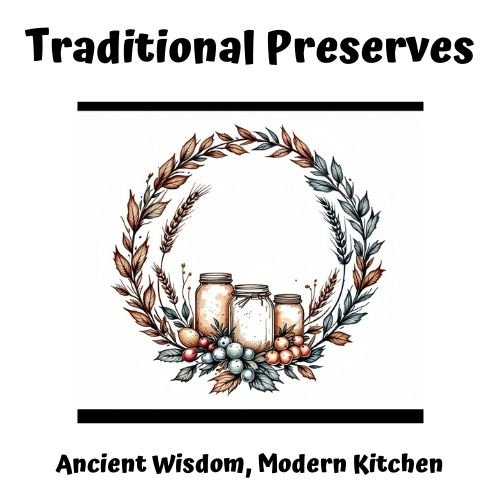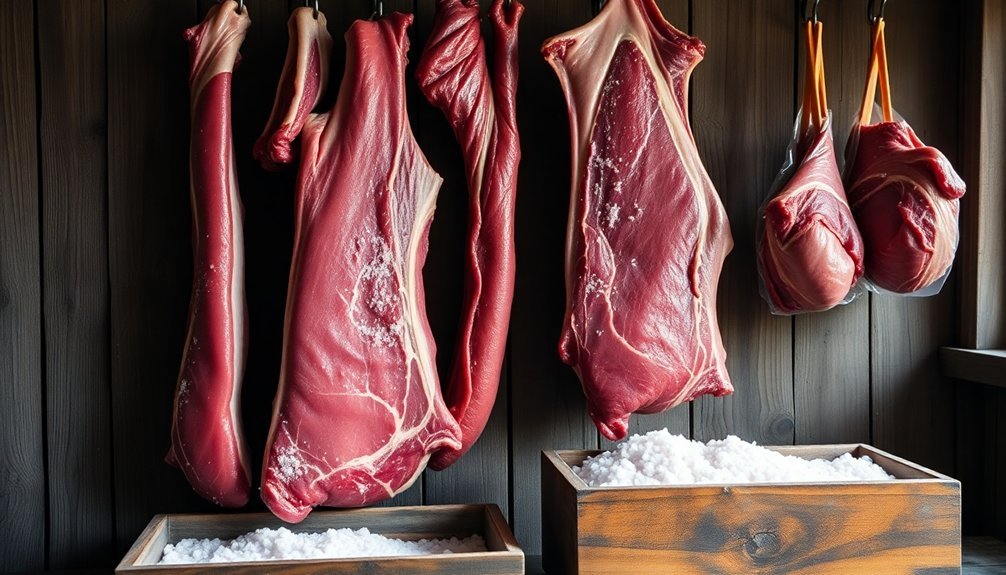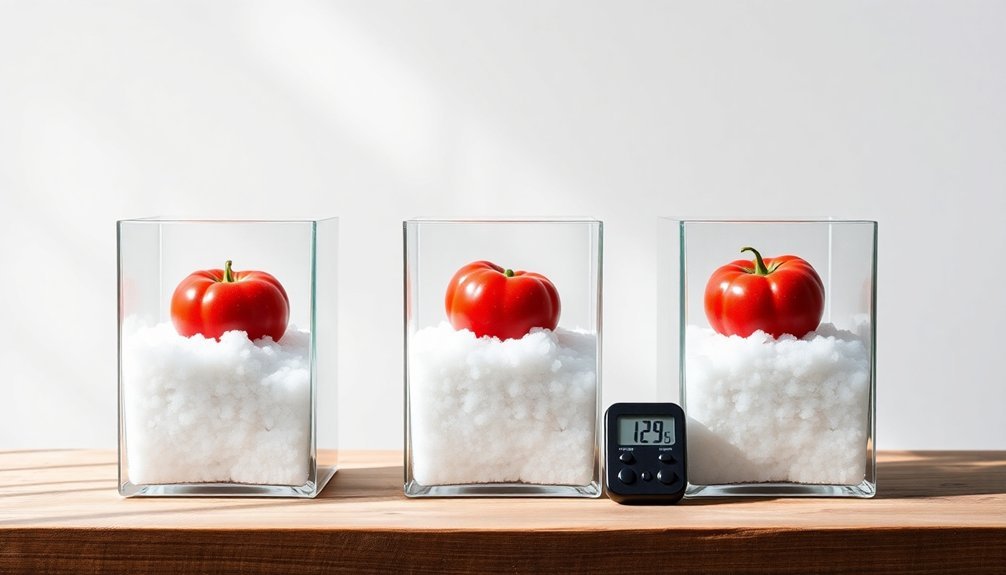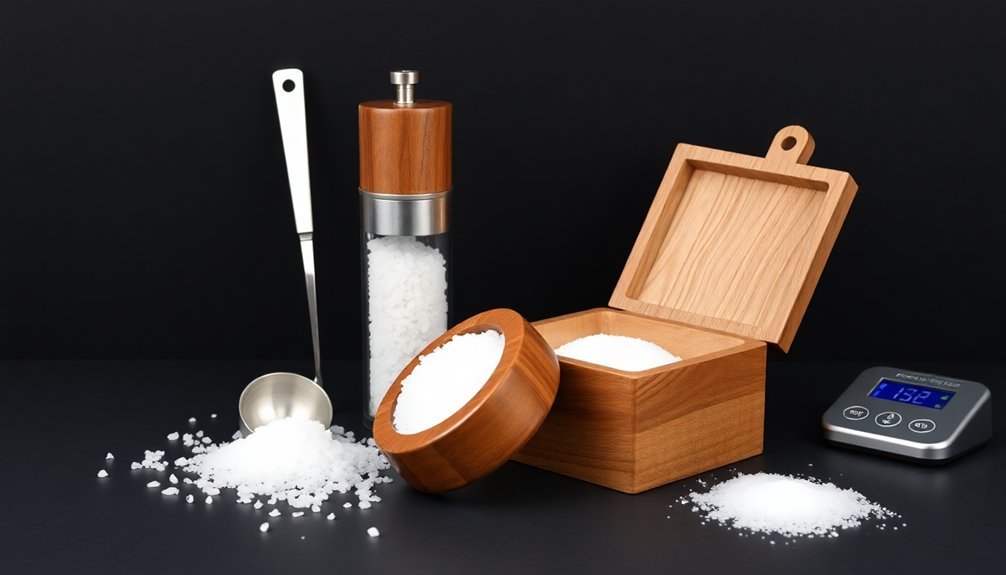When making homemade jam, you'll find the highest natural pectin levels in citrus fruits, with lemons leading at 16.61%, followed by oranges and tangerines. Red currants, blackcurrants, and cranberries also pack impressive pectin content, requiring minimal added sweeteners. Tart apples, especially varieties like Granny Smith and Candine, work wonderfully in jam-making, particularly when slightly under-ripe. Gooseberries, quince, and limes round out your top pectin-rich options. For best results, try combining low-pectin fruits like strawberries with these high-pectin varieties. Understanding the right harvesting times and preparation methods will transform your jam-making success.
Why Natural Pectin Matters

Nature's own thickener, pectin, plays an essential role in transforming fresh fruit into perfectly set preserves. When you use natural pectin in your jam-making process, you'll achieve better flavor while maintaining more of the fruit's nutritional value. You won't need to cook your preserves as long, which helps preserve the authentic taste of your fruit. Simple preparation steps like washing and dicing fruit uniformly will ensure even cooking and optimal pectin extraction.
You'll find that natural pectin offers multiple advantages over commercial alternatives. It's completely safe, plant-derived, and allows you to reduce the amount of sugar in your recipes. If you're looking to create more authentic preserves, natural pectin helps you achieve that traditional texture and taste you're after. By using fruits rich in natural pectin, you'll also save money and become less dependent on store-bought pectin products.
To make the most of natural pectin, you'll need to understand how it works. The key is balancing under-ripe and overripe fruit, as pectin levels are highest in fruit that hasn't fully ripened.
You can enhance natural pectin's effectiveness by adding citric acid or lemon juice at the right moment, which helps create the perfect gel while balancing sweetness.
Lemons and Limes
When you're seeking natural pectin powerhouses for your homemade jams, lemons and limes stand out as exceptional choices with their remarkably high pectin and acid content.
While the flesh has low pectin, these citrus fruits contain abundant pectin in their peels and seeds, making them particularly valuable because they're natural preservatives, eliminating the need for commercial additives in many recipes.
To get the most from your lemons and limes, focus on using their peels and slightly underripe specimens, which pack the highest pectin punch and will help your preserves set beautifully.
High-Acid Pectin Kings
The versatility of lemons and limes makes them true champions in the world of pectin-rich fruits. You'll find their highest pectin concentration in the zest and pips rather than the flesh, making these citrus powerhouses essential for natural jam setting.
When you're making jam, you'll benefit from these fruits' dual advantages: high pectin content and natural acidity, with a pH around 2. This combination means you won't need additional pectin or acid enhancers in your recipes. Adding them to your jam recipes will act as matchmakers for pectin molecules, ensuring proper gel formation.
You can also use lemons and limes to boost the pectin levels in other fruit jams that might struggle to set on their own.
If you're working with commercial pectin, remember it often contains acid already, so you'll want to adjust your recipe accordingly. For the best results, use the zest and pips, and cook your mixture just until it coats the back of a spoon.
Under-ripe lemons and limes pack even more acid punch than their ripe counterparts, which can be advantageous when you're aiming for a firm set.
These citrus fruits aren't just jam-making aids – they'll enhance your preserves' flavor profile while ensuring proper gel formation naturally.
Natural Preservative Properties
Lemons and limes serve as powerful natural preservatives in your homemade jams, offering a dual defense against spoilage. When you add these citrus fruits to your jam-making process, you're creating an acidic environment that naturally inhibits the growth of harmful bacteria, yeasts, and molds. This acidity doesn't just protect your jam – it's essential for proper pectin extraction and gelling.
You'll find that these citrus fruits work as natural antioxidants too, preventing your jam from oxidizing and maintaining its fresh flavor and vibrant color. They'll chelate metal ions that could otherwise trigger oxidative reactions, which helps extend your jam's shelf life.
If you're working with low-acid fruits, adding lemon or lime juice becomes particularly important for both safety and successful gel formation.
When you incorporate these citrus fruits into your jam recipes, you're tapping into time-tested preservation methods. They'll help maintain the quality of your preserves by creating the perfect balance of acidity needed for both food safety and proper setting.
You won't need artificial preservatives when you've got these natural powerhouses working in your homemade jams.
Processing Citrus Successfully
Successfully processing citrus fruits starts with proper preparation techniques that maximize their pectin-releasing potential. You'll want to begin by cutting your lemons and limes crosswise, removing any seeds to prevent unwanted bitterness. Using a microplane grater, carefully zest the outer peel while avoiding the white pith beneath.
- Always simmer citrus fruits for at least 40 minutes to extract maximum pectin
- Keep the heat low and stir frequently to prevent burning
- Add complementary ingredients like fresh herbs or ginger during the cooking process
- Monitor temperature with a candy thermometer until it reaches 220 degrees
- Use sterilized jars and proper sealing techniques for safe preservation
When cooking your citrus mixture, maintain a steady simmer while stirring regularly to guarantee even heat distribution. You'll notice the mixture gradually thickening as pectin is released.
Don't forget to incorporate any additional flavoring ingredients about 15 minutes before completion. Once your jam reaches the desired consistency, quickly transfer it to sterilized jars and seal them immediately.
For best results, store your finished citrus jam in a cool, dark place where it'll maintain its quality and flavor profile.
Cranberries in Jam Making

Bursting with natural pectin and tart flavor, cranberries create perfectly set jams without additional thickeners. You'll need just one pound of fresh or frozen cranberries and a cup of sugar to get started, though you can opt for alternative sweeteners like allulose, honey, or maple syrup.
To make cranberry jam, combine your ingredients in a saucepan and bring them to a simmer over medium heat. You'll want to cook the mixture for 45-60 minutes, stirring frequently to prevent burning.
Keep the lid slightly cracked to let steam escape while the cranberries burst and thicken.
You can customize your jam by adding warming spices like cinnamon, allspice, and cloves, or incorporate fruits like apple or pear.
Orange zest adds a bright citrus note that complements the tart cranberries beautifully.
Your finished jam will keep in the refrigerator for about six weeks, or you can process it using standard canning methods for longer storage.
Once cooled, you'll have a versatile spread that's perfect for breakfast items, baked goods, or holiday treats, while providing valuable nutrients like vitamin C and antioxidants.
Blackcurrants and Gooseberries
Nature's jellying agents abound in both blackcurrants and gooseberries, making them exceptional choices for homemade jam. You'll find these fruits naturally packed with pectin, eliminating the need for commercial additives.
When making blackcurrant jam, you can mix under-ripe and ripe fruits to achieve the perfect balance of pectin and flavor, while gooseberries offer their highest pectin content when they're young or unripe.
- Both fruits require minimal preparation – just remove stalks and wash thoroughly.
- Blackcurrants need a 1:1 fruit-to-water ratio, while gooseberries work best at 4:1.
- You'll notice gooseberries turn a lovely pink shade during cooking.
- Blackcurrant jam typically yields 7-8 jars, while gooseberry produces 3 half-pint jars.
- Testing for set is essential – use the chilled saucer method for both fruits.
For both varieties, you'll want to bring your mixture to a rolling boil after adding sugar. Blackcurrants need 5-15 minutes to reach setting point, while gooseberries set much faster, usually within 1-2 minutes.
Store your finished jams in sterilized jars in a cool, dry place, allowing them to set completely overnight.
Oranges and Citrus Fruits

While blackcurrants and gooseberries offer excellent pectin content, citrus fruits pack an even more powerful jellying punch. You'll find that oranges contain up to 3.5% pectin in their flesh, but it's the peels that are truly remarkable, containing up to 30% pectin.
If you're looking to maximize your pectin yield, lemons lead the pack at 16.61%, followed closely by oranges at 16.01% and tangerines at 15.23%.
When you're making homemade jam, you can harness citrus pectin in two ways. You can either use store-bought pectin powder, which is often derived from citrus peels, or incorporate citrus peels directly into your recipe.
By adding citrus-based pectin to your jams, you'll reduce cooking time and preserve more of your fruit's natural flavors.
The high degree of esterification in citrus pectin (over 78% for all citrus fruits) means you'll get a rapid-setting jam. You won't need to do traditional gel testing when using citrus pectin, as it reliably creates a firm set.
For the best results, combine different citrus fruits in your recipes to achieve both ideal gelling and balanced flavor.
Using Green Crab Apples
You'll find wild crab apples in abundance during late summer and early fall, typically from August through October when they're at their peak ripeness.
Look for bright green fruits that feel firm when gently squeezed, and gather them from areas free of pesticides or road pollution.
For the best jam-making results, pick the crab apples just before they start turning yellow, as this guarantees maximum pectin content and ideal tartness.
Sourcing Wild Crab Apples
Finding wild crab apples requires careful identification and knowledge of their natural habitats. You'll typically spot these trees along woodland edges, in open prairies, and near streams where they receive plenty of sunlight. Look for their distinctive reddish-brown to gray bark with shallow grooves, and watch for thorny branchlets that help identify the species.
When searching for wild crab apples, keep these essential identification features in mind:
- Fruits must be small (less than 3.5cm) and appear green to yellow when ripe
- Leaves should have shallow lobes with irregular teeth along the margins
- Look for trees in sheltered locations with alkaline soil
- Check for clusters of white or pink flowers in spring (April-May)
- Verify the presence of densely matted hairs on twigs and fruit stalks
You'll often find wild crab apples growing in thickets formed by suckers, making them easier to spot in groups.
When harvesting, remember that transplanting isn't recommended due to their deep rootstocks. Instead, focus on collecting fruits from established trees during the proper season. The high pectin content makes these fruits ideal for jam-making, though you'll need to verify proper identification before harvesting.
Best Harvest Time Tips
Throughout the summer months, harvesting green crab apples at the right time proves vital for maximizing their pectin content. You'll want to target early summer, typically around July, when the fruits are still firm and green.
Don't wait until they're fully ripe, as this will reduce the pectin concentration you need for successful jam-making.
Before you start bulk harvesting, test a few apples from different trees to guarantee good flavor and pectin content. The fruit should be hard, tart, and not yet sweet.
You'll find significant variation between trees, so this step is important for quality control.
When you're ready to harvest, gather your crab apples using canvas bags or paper sacks to prevent bruising. If you need to reach higher branches, keep a step stool handy.
Once you've collected your fruit, plan to process it quickly to maintain ideal pectin levels.
Remember that timing varies by location and seasonal conditions. While the main crab apple harvest typically runs from late summer to mid-fall, you'll want to collect green crab apples earlier.
Avoid harvesting after freezing temperatures, as this makes the fruit softer and reduces pectin content.
Quince for Traditional Preserves

The golden-hued quince stands as one of nature's richest sources of natural pectin, making it an ideal fruit for traditional preserves.
You'll find these large, fragrant fruits turning from green-yellow to golden as they ripen during long summers. While they're too sour and bitter to eat raw, they transform into delicious preserves through proper preparation.
To make quince jam, you'll need to wash and remove any protective fur from the fruit before cutting it into halves. Keep the pectin-rich skin intact as you remove the core.
Cook the chunks in boiling water until soft, then mash them thoroughly. You'll achieve the best results by adding 400g of sugar per kilogram of quince, along with a splash of lemon juice.
- Natural pectin guarantees perfect setting without commercial additives
- Cooking transforms the mixture into a beautiful pink/orange color
- Traditional method requires about 40 minutes of cooking time
- Proper sterilization of jars extends preservation time
- Simple cold plate test confirms when jam reaches ideal consistency
As you cook and stir the mixture, you'll notice it thickening naturally.
Once it holds its shape when tested on a cold plate, your preserve is ready for jarring.
Tart Apples and Berries
When you're making homemade jam, choose firm green apples and tart berries like cranberries or gooseberries, which naturally contain high levels of pectin.
You'll want to store your apples in a cool, dry place at around 32-40°F (0-4°C) to maintain their firmness and pectin content.
For the best results, pick slightly under-ripe apples and berries, as they contain more pectin than fully ripened fruit.
Best Cooking Varieties
Many successful jam makers rely on two primary fruit categories for their homemade preserves: tart apples and berries. When selecting apples, you'll want to choose firm varieties like Granny Smith, which offer the perfect balance of tartness and structure.
Candine and Envy apples are excellent alternatives, providing the ideal combination of sweetness and acidity needed for jam making. For berry-based jams, you'll find that blackberries are naturally rich in pectin, making them perfect for preserves, while strawberries might need additional pectin for proper setting.
Key points to remember when selecting your fruit varieties:
- Choose firm, ripe apples over soft or overripe ones to maintain proper jam texture
- Opt for Granny Smith apples when you want guaranteed tartness and stability
- Select fresh or frozen berries that are free from mold and blemishes
- Combine low-pectin fruits like strawberries with high-pectin varieties for better results
- Consider using quince as a natural pectin booster when mixing with other fruits
You'll need to adjust your cooking approach based on your chosen fruit variety, as each type requires different preparation methods and pectin amounts to achieve the perfect consistency.
Storage Tips For Firmness
Proper storage techniques directly impact your jam's firmness and longevity. When working with tart apples, you'll want to stockpile cores, peels, and scraps in your freezer until you've collected enough for your recipe. Choose sour varieties like Granny Smith or Newton Pippin, as they're high in pectin and provide better gelling properties.
For berry jams, you'll need to add commercial or homemade apple pectin since berries are naturally low in pectin. Use one 4-ounce jar of homemade pectin for every 3 pounds of fruit, or follow the package directions for commercial pectin. You can test the set using the wrinkle method on a cold plate – if it wrinkles when pushed with your finger, it's ready.
Store your jams in a cool, dry place and be patient, as jams made with homemade apple pectin may continue to set for up to a month after storage.
When using berries, make sure you've achieved a full rolling boil with the pectin before adding sugar. If you notice excessive foam, you can add a small amount of butter after removing from heat, though this isn't recommended for long-term storage.
Red Currants

Red currants' exceptional pectin content makes them a prime choice for homemade jam making. Their high vitamin C content (46% DV) and dietary fiber (15% DV) make them not just tasty, but also nutritious.
You'll find these berries versatile enough for both sweet and savory dishes, though they're most commonly used in jams, jellies, and preserves throughout Europe.
When making red currant jam, you can reduce cooking time by adding pectin, guaranteeing proper gelling without continuous testing. Don't forget to sterilize your jars before filling them with hot jam – this guarantees your preserves will last up to 3 months in the fridge.
- Rich in antioxidants that protect your cells from free radical damage
- Contains vitamin K for healthy blood clotting and bone development
- Provides potassium to maintain proper fluid balance in your body
- Offers manganese to support connective tissue development
- Includes essential minerals like magnesium, iron, zinc, and phosphorus
Adding a small amount of butter while cooking can help reduce foaming in your jam.
You'll benefit from red currants' natural acidity, which contributes to both flavor and preservation while adding a bright, tangy taste to your homemade preserves.
Best Harvesting Times
Successful jam-making starts with harvesting fruits at their ideal pectin levels. For high-pectin fruits, you'll want to gather tart, underripe apples early in the harvest season while they're still green and firm.
Similarly, collect blackberries when they're still green or slightly red in late spring or early summer to maximize their pectin content. You can harvest lemons and limes year-round in warm climates, using both peel and juice for their high pectin concentration.
Crab apples are best picked in early to mid-fall when they're small and tart. For moderate-pectin fruits, gather ripe apples in mid to late fall, and pick blackberries in late summer when they're fully ripe.
Harvest sour cherries and chokecherries in mid to late summer. Low-pectin fruits require different timing. You'll want to collect strawberries in spring through early summer when they're fully ripe.
Gather blueberries in mid to late summer when they're sweet, and pick sweet cherries during mid to late summer. Remember that with low-pectin fruits, you'll need to add commercial pectin or combine them with high-pectin fruits for successful jam-making.
Frequently Asked Questions
Can I Substitute Commercial Pectin With Chia Seeds in Homemade Jams?
Yes, you can substitute pectin with chia seeds in your homemade jams. They'll create a similar thickening effect when combined with fruit, though you'll get a slightly runnier texture and shorter shelf life.
Does Freezing Fruit Before Making Jam Affect Its Natural Pectin Content?
Freezing your fruit won't reduce its natural pectin content, and it'll actually help release more pectin during cooking. You'll get up to 3-4 times better pectin extraction thanks to the cell wall disruption.
How Long Can Homemade Pectin Extracted From Fruit Peels Be Stored?
You can store properly prepared homemade pectin for up to 12 months. If you've canned it in sterilized jars, keep it in a cool, dry place. Once opened, use it within 6-12 months.
Can Pectin-Rich Fruits Be Combined With Low-Pectin Fruits for Better Setting?
Yes, you can combine high-pectin fruits like apples or citrus with low-pectin fruits like strawberries or peaches. It'll help your jam set naturally and create a better texture without using commercial pectin.
Should Sugar Be Reduced When Using Multiple High-Pectin Fruits Together?
Yes, you can reduce sugar when combining multiple high-pectin fruits, as they'll naturally create a firmer set. However, don't cut too much sugar, as it's still needed for proper preservation and flavor balance.
In Summary
You'll find that using these pectin-rich fruits in your homemade jams saves you money and helps you avoid artificial additives. Remember to harvest or purchase your fruits at peak ripeness for the best natural pectin content. Whether you're making traditional preserves or trying new jam combinations, these fruits will give you that perfect gel without commercial pectin. Start experimenting with these natural options in your next batch!





Leave a Reply